It is difficult to imagine an autumn flower garden without perennial chrysanthemums. Their multicolor pleases the eye when the leaves on the trees have already circled, and there are simply no other garden flowers. Planting and caring for perennial chrysanthemums have their own nuances, but they do not present special difficulties.
Material Content:
Varieties and types
These perennial plants with flowers collected in baskets differ in both the height of the bushes and the size of the flowers and their color.
Chrysanthemum Alpine.
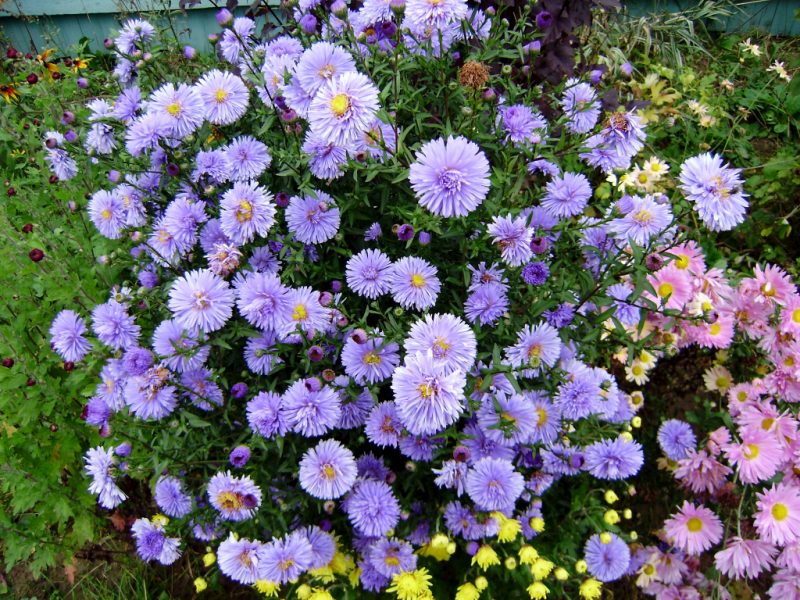
These are bushy chrysanthemum flowers. A view for placement on an alpine hill, since the height of the plant does not exceed 14 cm. Its leaves are pinnately dissected gray-green, the flowers look like single baskets with a diameter of 3 to 5 cm. Flowering in mid-summer. Winters without shelter.
Chrysanthemum Korean.
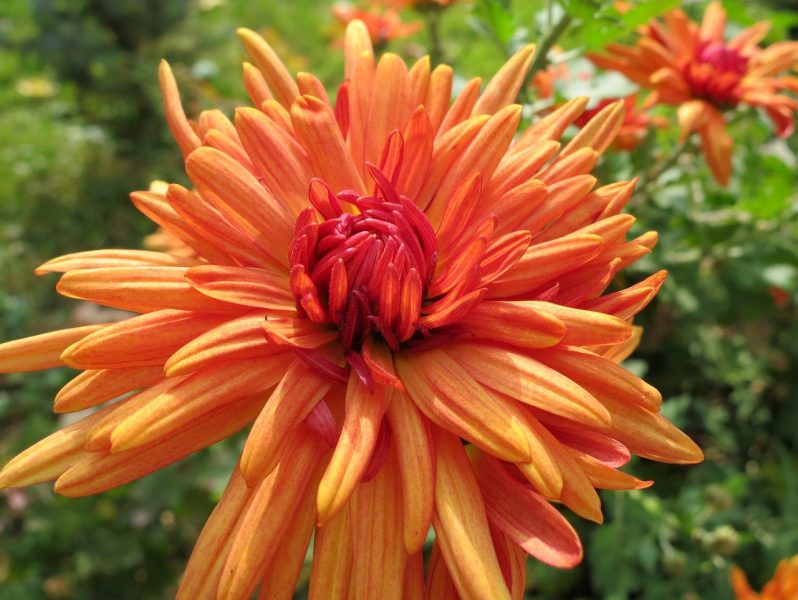
This chrysanthemum is most often grown in regions with frosty winters. Despite the fact that she came from southern countries (Korea, Japan, China), the upheavals of our climate can withstand quite well, although she needs shelter.
Interesting varieties listed in the State Register of Breeding Achievements:
- Altyn Ay. The bush is not higher than 60 cm. It carries yellow double flowers on strong peduncles up to 8 cm in diameter. It begins to bloom in mid-August. It blooms profusely and lasts more than 2 months.
- Dina. The bush is about 45 cm high. Flowering begins after August 10. The flowers are white, with a diameter of 8 cm. Flowering is very long - up to 70 days.
- Zemfira. It blooms in late July. Blooms for almost 3 months with medium-sized and non-double blooms of light pink color.
- Autumn Dreams. Blooms for almost 3 months with yellow semi-double flowers with a diameter of 7.5 cm.
There are varieties that have not passed the tests, but no less interesting:
- Bacon Bright red flowers on a bush up to 85 cm high bloom in September. They are terry, have a diameter of 5 cm.
- Evening lights. Inflorescences are simple red with a yellow ring.
- Orange sunset. Terry flowers, large (up to 11 cm), orange. Bush about 80 cm high.
- Malchish-Kibalchish. A short plant, not higher than 35 cm. It blooms with simple pink flowers in late summer.
- Umka. Tall, up to 110 cm, the bush is decorated with large pompom flowers with a diameter of up to 8 cm in white or slightly pinkish color.
- A stranger. Winter-hardy variety blooming since the end of July. Initially white, large flowers gradually tint at the tips in a lilac color.
- Inspiration. Terry flowers up to 10 cm in diameter, have a fragrance. Blossom in September. Differ in winter hardiness.
A special place is occupied by border garden chrysanthemums. Their bushes do not grow above 30 cm and without any formation take a spherical shape.
The best varieties:
- Talisman - flowers of beet and raspberry color;
- Barbarian with lilac and purple flowers.
Perennial chrysanthemums: the nuances of growing
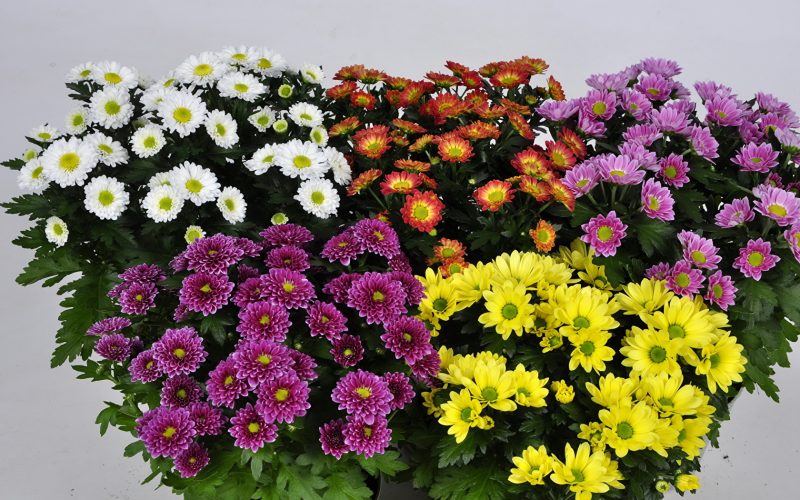
Chrysanthemum is a southerner and few species have been able to adapt to our climate. Beautiful large-flowered varieties can be grown only in the south. Even more frost-resistant Korean chrysanthemums can freeze in snowless winters. The peculiarity of plants is that they do not like wet wintering, so drainage is mandatory for them. Another nuance is that the chrysanthemum bush is short-lived and needs to be updated every 3 years.
Outdoor landing
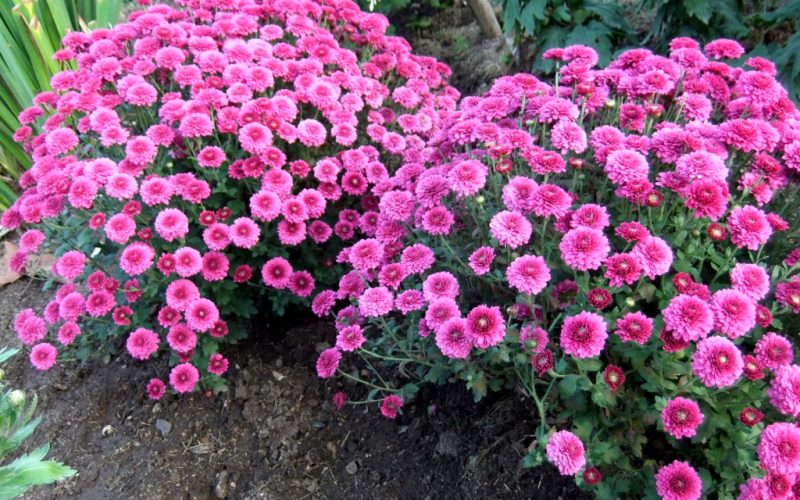
In open ground, you need to grow varieties adapted for frosty winters. Zoned varieties and grown from seeds grow, bloom, and winter best.
Soil preparation and location
A place for chrysanthemums is chosen sunny, fully lit throughout the day. Even slight shading will inevitably affect flowering, and the stems of the plants will stretch. It is necessary to provide for wind protection. The site should not be dry, but this flower also does not tolerate stagnation of water.
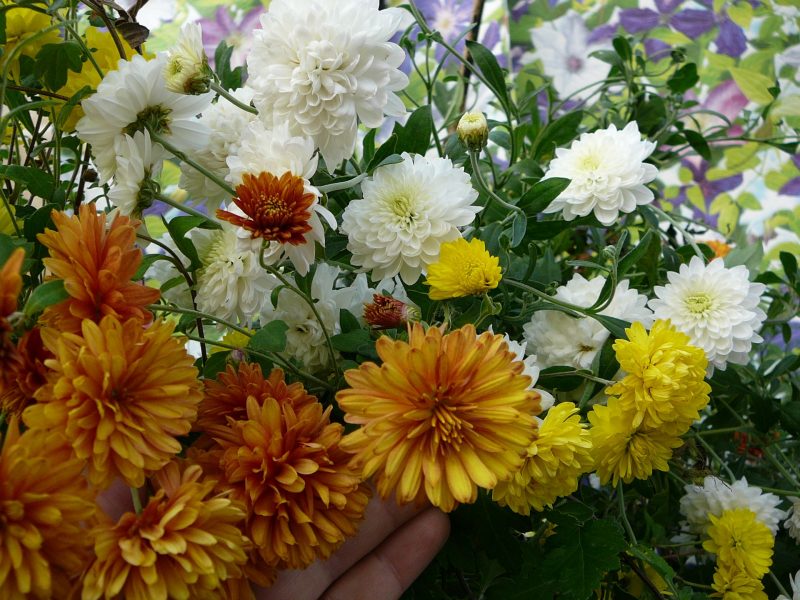
The soil for chrysanthemums must meet the following requirements:
- to be loose, any mechanical composition except heavy clay is suitable;
- good water and air permeability;
- have a slightly acid reaction, so it is useful to add peat to the planting pit;
- be fertile - on lean soils, flowering will be sparse.
Under digging for each square. m make up to 20 kg of humus, 100 g of superphosphate and potassium sulfate, 30 g of urea. On heavy soils, sand is added for drainage.
Fresh manure should not be added under chrysanthemums - plants cannot tolerate it.
How and when to plant?
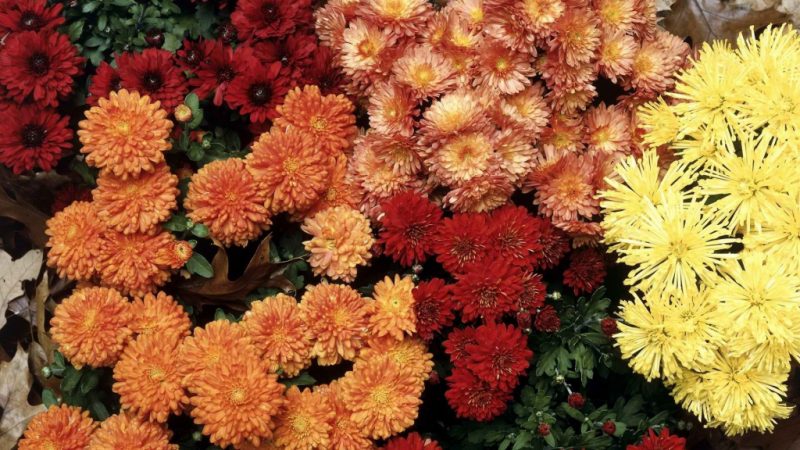
Typically, chrysanthemums are on sale in the fall, it is at this time that their flowering and compliance with varietal characteristics are visible. They come in pots, so they need a transplant. But in autumn it is better not to disturb the flowers, otherwise lunges in winter are inevitable. The plant gives all its strength to flowering, but they simply will not remain to root. The best time to plant chrysanthemums is spring. In the southern regions, it is carried out at the end of April or in May, and in the northern regions it will be necessary to wait until the end of spring return frosts.
- Plants are planted in holes 40 cm deep, on the bottom of which you need to put drainage.
- A handful of humus is added to each well and the soil is well shed. Chrysanthemums are not buried during planting.
- The distance between plants is about 40 cm, between rows - 50 cm.
- It is necessary to provide support for the bushes in the form of strong pegs, to which the plants are tied.
Chrysanthemum Care
In order for the plants to be healthy and bloom well, they must be properly looked after. The first thing that is done after rooting the cuttings is to pinch the top for better tillering. After 3 weeks, the pinch is repeated, forming a spherical shape of the bush. If the cuttings were received late, this operation does not need to be carried out, such chrysanthemums are grown in a single-stemmed culture. During the growing season, regular weeding, loosening of the soil, irrigation and top dressing will be required.
Watering a plant
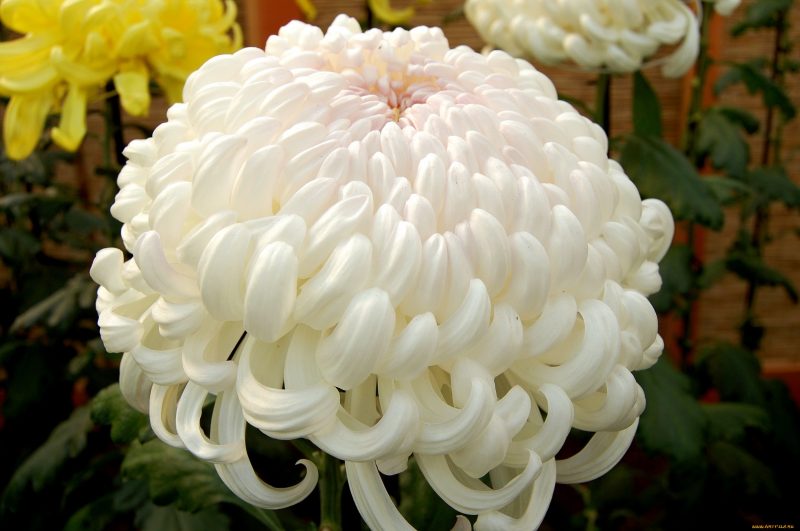
Chrysanthemums are sensitive to a lack of moisture, this makes the stems stiff, and you can’t get full bloom. Excess water is also harmful - it contributes to the decay of the roots. Therefore, you need to seek a middle ground and focus on weather conditions. Watering in dry weather and during flowering is especially needed. Watered with settled water and only under the root.
Fertilizer and fertilizer

Fertilizing chrysanthemums requires both mineral and organic.
- Every 2-3 weeks they are fed a solution of mineral fertilizer. In the first half of the growing season with a predominance of nitrogen, in the second - phosphorus and potassium at the rate of 40 g per ten-liter bucket (this amount is enough for 2 square meters of landings).
- 3 times per season are fed with mullein infusion in a ratio of 1:10. Each plant will require a liter of solution.
All top dressing combined with clean watering. The next day, the soil needs to be loosened.
Care after flowering and preparation for winter
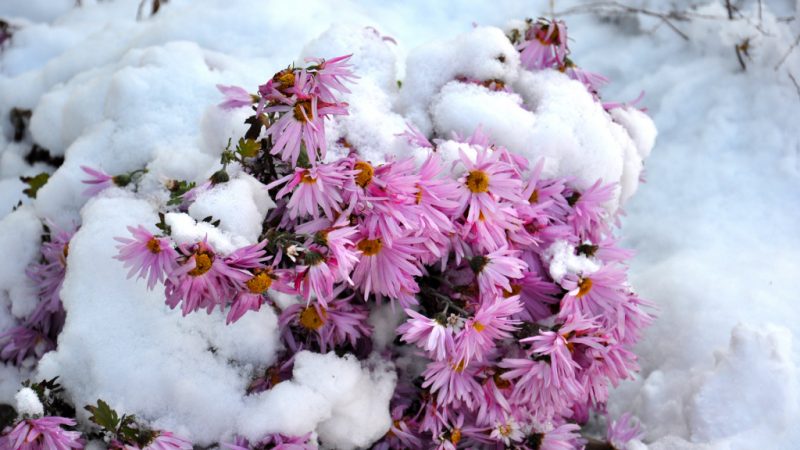
This is the time to prepare for winter. In order for the wintering to be successful, a number of events need to be carried out.
- Plants are fed with phosphorus and potash fertilizers.
- Pruning the bushes, leaving about 15 cm of the stem.
- Spud with earth brought from another part of the site so as not to expose the roots.
- Fall asleep with a layer of dry leaves up to 40 cm thick.
- It is covered with snow retarding material - spruce branches or dry branches.
Transfer
Chrysanthemums are short-lived. In the third year, the middle of the bush falls out, and the flowers fade.
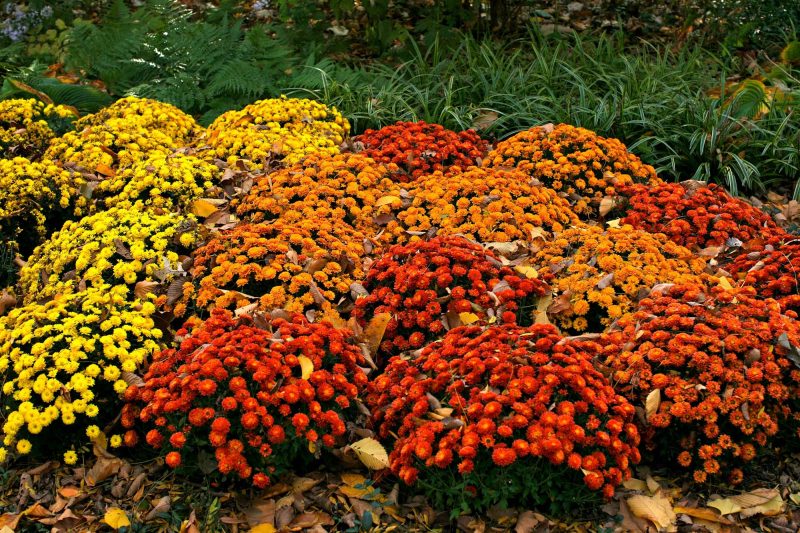
To renew the bushes and give them a new life, the chrysanthemum is divided and planted in a new place.
Transplant time is spring. The bush needs to be carefully dug out, slightly shaking off the ground. Divide the plants with a sharp knife. Each dividend should have kidneys and roots. Further actions are the same as when planting cuttings.
Reproduction of perennial chrysanthemum
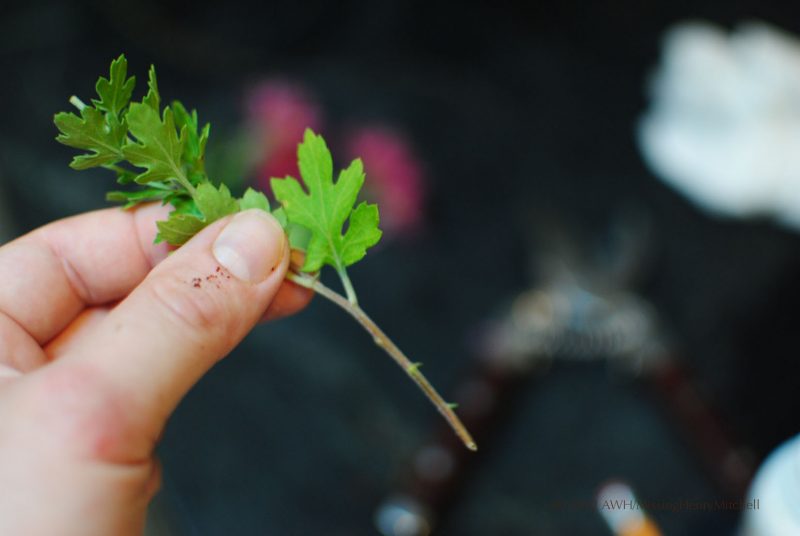
Perennial garden chrysanthemums are propagated by dividing the bush, grafting and sowing seeds. The latter plants will be best adapted to the climate at the place of cultivation.
- Seeds for seedlings are sown at the beginning of March in a mixture of the following composition bought in a store or prepared independently: garden soil, peat and humus in equal quantities.
- At the bottom of the tank for sowing lay drainage.
- Seeds of perennial chrysanthemum are sown superficially, slightly pressing them to the ground.
- The container is covered with a plastic bag and put in a bright place with a temperature of 25 degrees.
Immediately after emergence, the package is not removed, but is done gradually, accustoming the plants to fresh air. When the shoots get two real leaves, they are dived into separate cups.
Seedling conditions:
- temperature is 18 degrees;
- a lot of light, if necessary - illumination;
- top dressing every 14 days with a solution of a complete mineral fertilizer.
Seedlings are planted in the ground after frost, trying to preserve the roots as much as possible.
With seed reproduction, the parental traits are not preserved.
For spring cuttings, you need to dig the plant back in the fall, plant it in a pot and look after it in the winter like a room flower. Cuttings are harvested from young shoots 5 cm long, removing the lower leaves. Planted in a container of sand under a glass jar. After rooting, the cuttings are grown and planted in the ground.
Plant diseases and pests
When growing garden perennial chrysanthemums, you can encounter some diseases.
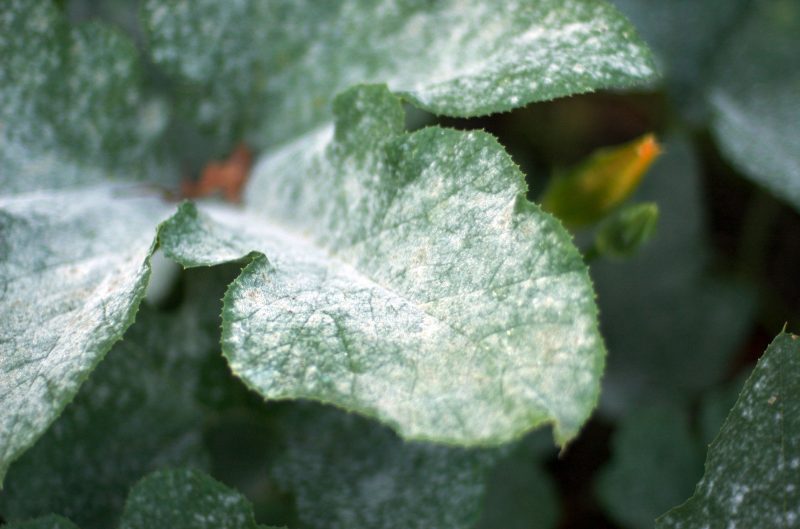
Fungal diseases:
- gray rot (brown spots on the leaves, covered with a gray coating);
- powdery mildew (white coating);
- rust (small specks of chlorosis).
All of them are treated with copper-containing fungicides, and colloidal sulfur is also effective against rust.
Viral diseases:
- mosaic (speckled spots on the leaves);
- aspermia (deformed flowers and speckled leaves);
- dwarfism (small stature, not suitable for the variety, premature flowering).
There is no cure; diseased plants are destroyed.
The main pests of chrysanthemums: nematodes, meadow bugs, aphids. In the first case, the fight against the pest is impossible. The plant is destroyed. As a preventive measure, they spill the earth with a solution of phosphamide. From the bug and aphids, you can try the treatment with infusions of onion husks or hot peppers. If this does not help, treat the plants with insecticides.












